#192: Coprinellus micaceus, The Mica Cap
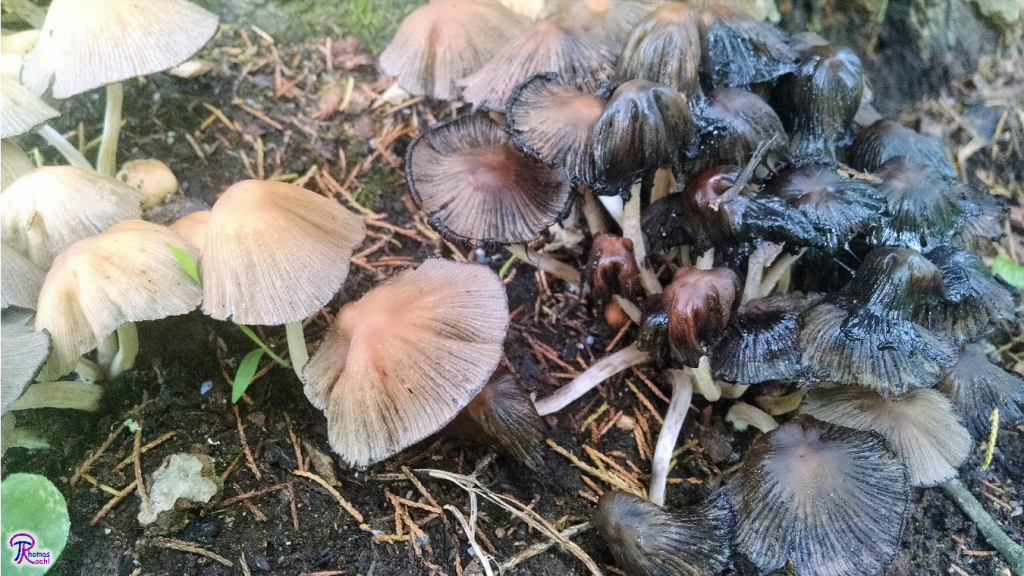
Coprinellus micaceus has gills that liquefy at maturity and a pileus that is covered in mica-like granules.
Coprinellus micaceus, commonly known as “The Mica Cap” or “The Glistening Inkcap” is one of the rare inky caps (FFF#177) that is easy to identify. These medium-sized mushrooms appear in dense clusters on dead wood and feature brown caps coated with a distinctive dusting of salt-like or mica-like granules (hence the scientific and common names). Mica Caps are beautiful when young, since the shiny granules make it look like fairy dust was lightly sprinkled over the mushrooms. The unique combination of size, habitat, and fairy dust makes C. micaceus instantly recognizable.
Description
C. micaceus mushrooms are for the most part umbrella-shaped, although they tend to be a bit rounder at the top than most umbrellas. The mushrooms grow larger than many inky caps, reaching sizes of 2-6cm wide and 2-8cm tall and sometimes even bigger. You usually find Mica Caps growing in large and dense clusters that make these otherwise drab mushrooms easy to spot.1–4
The pileus is the most important part of C. micaceus for identification. At first, the pileus is ovoid but it soon expands like an umbrella to become convex or somewhat bell-shaped.1–4 I find that the pileus is usually a bit irregular; it often has a few radial wrinkles that divide it into faint lobes. The cap is some shade of light brown, from yellow-brown to red-brown. This color is deepest at the center of the pileus and gradually becomes paler toward the edge. As the mushroom matures, the colors fade to pale brown and can even become grayish if the gills underneath are mature. One of the most conspicuous features of the pileus is the grooves that extend from the margin to near the center.1–4
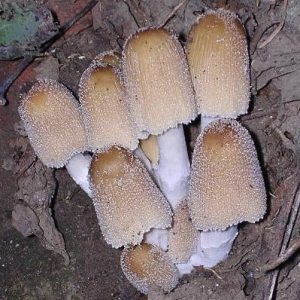
The Mica Cap got its name because of the shiny dust-like granules that dot its surface. Photo by Roberto Zanon [GFDL, CC-BY-SA-3.0 or CC BY-SA 2.5], via Wikimedia Commons
Underneath the pileus, the Mica Cap produces gills that radiate out from a central stipe. The gills can be attached or free from the stipe and start out whitish but darken to brown and eventually to black as the mushroom ages. Once the gills are mature, they deliquesce from the edges inward, which turns most – but usually not all – of the cap into inky black goo. The resulting “ink” is teeming with black spores, which give the ink its dark color.1–4
The stipe is the most boring part of the Mica Cap. It is long, thin, white, and smooth. Sometimes, it takes on some brownish color (especially near the base) or is covered with tiny hairs or granules. There is no evidence of a ring or ring zone on the stipe, which helps separate C. micaceus from many similar inky caps. The stipe is fibrous and hollow, which makes it feel rather flimsy.1–5
Ecology
C. micaceus is saprobic and gets its energy by decomposing wood. Its favorite meals are stumps, logs, and buried wood.1–4 Most of the time, the mushrooms grow on wood or right next to wood. I usually find them directly at the bases of trees, even when the trees seem healthy. When it grows from buried wood, the mushrooms fruit directly from the ground. The Mica Cap is not very picky about the type of wood it decomposes, which is unusual in the mushroom world.1–4
The Mica Cap is a common mushroom in North America and Europe but also grows in more limited areas of South America, Asia, and Australia.2 Although it evolved to live in forests, C. micaceus does well in urban landscapes and is a common sight in gardens and cultivated areas. You can find this mushroom in spring, summer, and fall and occasionally in winter.1 In my experience, it is one of the first gilled mushrooms to appear after the end of winter.
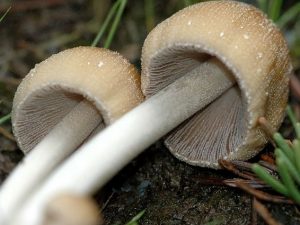
Mica Caps have gills that start out white but soon turn brown and then black before they finally liquefy. Photo by James Lindsey (Ecology of Commanster) [CC BY-SA 2.5 or CC BY-SA 3.0], via Wikimedia Commons
Similar Species
There are many brownish inky caps out there, but the habitat and morphology of C. micaceus easily separate it from look-alikes. Its growth on wood readily distinguishes it from the many inky caps grow on manure, straw, and similar nitrogen-rich habitats (unless C. micaceus is being difficult and growing from buried wood in a manured lawn). Its medium size and clustered growth also eliminate many small (less than 3cm across when mature) or solitary species.5 The mushroom most similar to C. micaceus is probably Coprinopsis atramentaria. However, that mushroom is larger, darker brown, and lacks the mica-like granules.5,6
Edibility
The Mica Cap is considered an edible mushroom, although it does not have much flavor.2,3,6 Of course, you should collect only specimens that have not yet begun to liquefy.6 The inky ones are hard to transport and do nothing for your dish other than make a big mess. Also, be prepared to cook them very soon, as Mica Caps deliquesce quickly.3 Since they have such a bland flavor, you can add them to just about anything. In that respect, C. micaceus is like a thinner version of the button mushrooms (Agaricus bisporus, FFF#002) you find at the grocery store. Because they are rather thin-fleshed mushrooms, you need a lot of them to make a decent dish. Thankfully, the mushrooms usually fruit in large clusters, often with caps at various stages of maturity. This makes it easy to find large enough quantities of young mushrooms.
Taxonomy
C. micaceus may be listed as Coprinus micaceus in older field guides. Coprinus once included all inky caps, but mycologists eventually split the genus up based on microscopic and genetic differences.2,4,6 Coprinus now contains only relatives of the Shaggy Mane (Coprinus comatus), which belong to a different lineage than most inky caps.2 Along with the bulk of the inky caps, the Mica Cap belongs to the family Psathyrellaceae. Read more about inky cap taxonomy on FFF#177.
| Kingdom | Fungi |
| Division (Phylum) | Basidiomycota |
| Subdivision (Subphylum) | Agaricomycotina |
| Class | Agaricomycetes |
| Subclass | Agaricomycetidae |
| Order | Agaricales |
| Family | Psathyrellaceae |
| Genus | Coprinellus |
| Species | Coprinellus micaceus (Bull.) Vilgalys, Hopple & Jacq. Johnson7 |
This post does not contain enough information to positively identify any mushroom. When collecting for the table, always use a local field guide to identify your mushrooms down to species. If you need a quality, free field guide to North American mushrooms, I recommend Michael Kuo’s MushroomExpert.com. Remember: when in doubt, throw it out!
See Further:
http://www.mushroomexpert.com/coprinellus_micaceus.html
http://www.messiah.edu/oakes/fungi_on_wood/gilled%20fungi/species%20pages/Coprinellus%20micaceus.htm
Citations
- Kuo, M. Coprinellus micaceus (MushroomExpert.Com). MushroomExpert.Com (2008). Available at: http://www.mushroomexpert.com/coprinellus_micaceus.html. (Accessed: 23rd June 2017)
- O’Reilly, P. Coprinellus micaceus, Glistening Inkcap mushroom. First Nature Available at: http://www.first-nature.com/fungi/coprinellus-micaceus.php. (Accessed: 23rd June 2017)
- Miller, O. K. & Miller, H. North American mushrooms: a field guide to edible and inedible fungi. (Falcon Guide, 2006).
- Emberger, G. Coprinellus micaceus. Fungi Growing on Wood (2008). Available at: http://www.messiah.edu/oakes/fungi_on_wood/gilled%20fungi/species%20pages/Coprinellus%20micaceus.htm. (Accessed: 23rd June 2017)
- Kuo, M. Coprinoid Mushrooms: The Inky Caps. MushroomExpert.Com (2008). Available at: http://www.mushroomexpert.com/coprinoid.html. (Accessed: 23rd June 2017)
- Volk, T. J. & Mundt, M. Public Description of Coprinellus micaceus (Bull.) Vilgalys, Hopple & Jacq. Johnson. Mushroom Observer (2011). Available at: http://mushroomobserver.org/name/show_name_description/113. (Accessed: 23rd June 2017)
- Coprinellus micaceus. Mycobank Available at: http://www.mycobank.org/BioloMICS.aspx?TableKey=14682616000000067&Rec=166882&Fields=All. (Accessed: 23rd June 2017)







![#011: Characteristics of Kingdom Fungi [Archived]](https://www.fungusfactfriday.com/wp-content/themes/hueman/assets/front/img/thumb-small-empty.png)

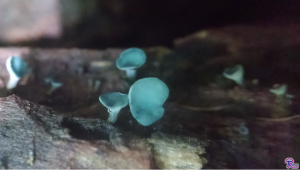
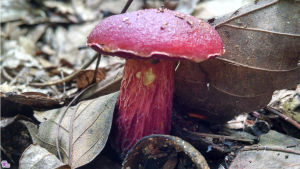
1 Response
[…] and other fine plant debris.7 Another potential point of confusion is Coprinellus micaceus (FFF#192). This species has distinctive universal veil remnants: the veil breaks up into small shiny […]